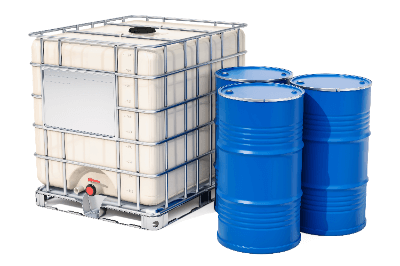What Is a Fiberglass Reinforced Plastic (FRP) Tank?
 Fiberglass Reinforced Plastic (FRP) Tanks are tanks made of lightweight, rust-resistant fiber-reinforced plastic. FRP is a weather-resistant and durable material. For this reason, it is used for the exterior walls of automobiles and ships.
Fiberglass Reinforced Plastic (FRP) Tanks are tanks made of lightweight, rust-resistant fiber-reinforced plastic. FRP is a weather-resistant and durable material. For this reason, it is used for the exterior walls of automobiles and ships.
Products with high chemical resistance are also available, and they feature high performance as tanks for storage. They are also used for storing radioactive isotopes and other materials generated at nuclear power plants.
Products with rigid polyurethane foam or polystyrene foam laminated between FRP tanks are sold as tanks with excellent heat retention and insulation properties.
Uses of Fiberglass Reinforced Plastic (FRP) Tanks
FRP Tanks are manufactured and used in a wide range of applications, from consumer products to industrial products.
Specific applications are as follows:
- Tanks for chemicals such as sulfuric acid and hydrochloric acid
- Temporary storage tanks for water supply
- Brine storage tanks for refrigeration equipment
- Temporary storage tanks for industrial wastewater
- Supply tanks for fire hydrants
- Tanks for storing liquid waste for medical and research use
- Tanks for circulating liquid in scrubbers
FRP tanks with excellent heat retention properties are used in applications such as hot and cold water tanks and brine tanks. They are also used for liquid waste and chemical tanks from medical facilities due to FRP’s high chemical resistance. They can also be used as hot spring tanks in sulfur springs and other hot spring facilities.
As described above, FRP tanks are used in a wide range of applications, and products with various specifications are sold.
Principle of Fiberglass Reinforced Plastic (FRP) Tanks
FRP Tanks are made of a material called FRP, which stands for “Fiber Reinforced Plastics” and refers to plastic reinforced with glass fiber.
Large FRP Tanks are designed to be simple by eliminating internal supports and stays to prevent corrosion.
Other Information on Fiberglass Reinforced Plastic (FRP) Tanks
1. Material of Fiberglass Reinforced Plastic (FRP) Tanks
FRP has different performance depending on the combination of resin plastic and fiber.
The following are two typical materials used for FRP tanks:
Vinylester resin
Bisphenol resins are highly resistant to both acids and alkalis and can be used for corrosion-resistant tanks. The Novolac type has particularly high acid resistance and is used for tanks for strong acids, and it is also a heat-resistant material. Since it is more resistant than unsaturated polyester, it is used for waste liquid tanks.
Unsaturated Polyester Resin
Unsaturated polyester is less resistant than vinyl ester. Isophthalic resins in particular do not have strong chemical resistance and are generally used for water tanks. Bisphenol resins have general corrosion resistance and are used for reinforcing layers in tanks.
2. Manufacturing Method of Fiberglass Reinforced Plastic (FRP) Tanks
There are several types of manufacturing methods for FRP tanks. Typical manufacturing methods are as follows:
Hand lay-up method
A mold is manufactured as the base of the tank, and the resin base material and fiber base material are laminated. After drying, the resin base material is impregnated and applied with a roller or brush. The process can be applied to all sizes and complex shapes. However, the process is expensive because it is all done by hand, and quality varies depending on the skill level of the operator.
Spray-up method
Fibers and resin are sprayed onto the mold with a spray gun, and the mold is released after curing. This method is more productive than the hand lay-up method, and is suitable for large-lot production to a certain extent.
Filament Winding Method
Resin-impregnated glass fiber roving yarn is wound around a mold rotating at a constant speed. This method is suitable for manufacturing large cylindrical tanks and is more productive than the hand lay-up method. It can produce products with uniform and excellent strength characteristics and high dimensional accuracy.
Lining Method
This method is used for the purpose of anticorrosion treatment of concrete and steel tanks. The tank surface is cleaned and polished, and primer is applied. A fiber base material is attached on top of the primer, and the resin is laminated with a roller or brush. Depending on the quality of the liquid, multiple layers can be applied.
3. Advantages and Disadvantages of Fiberglass Reinforced Plastic (FRP) Tanks
Compared to stainless steel tanks, FRP tanks have the following advantages and disadvantages:
Advantages
- Low cost
- Light weight and easy to install and repair
- Heat-retaining properties can be added.
Disadvantages
- Deteriorates due to ultraviolet rays
- Vulnerable to heat and shock
- Difficult to recycle when no longer needed
In particular, recycling methods have not been established for carbon fiber reinforced tanks.
4. Service Life of Fiberglass Reinforced Plastic (FRP) Tanks
For receiving water tanks in condominiums, etc., the service life is estimated to be 15 years. However, since repairs are possible, the tanks can be used for longer periods depending on the environment in which they are used. Generally, large-scale repair work is planned at 10-year intervals for condominiums. Rarely do condominiums have sufficient funds for repairs, and receiving water tanks are repaired and reused.